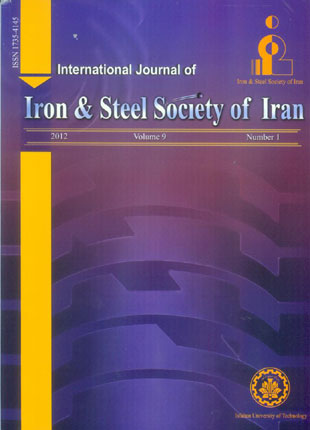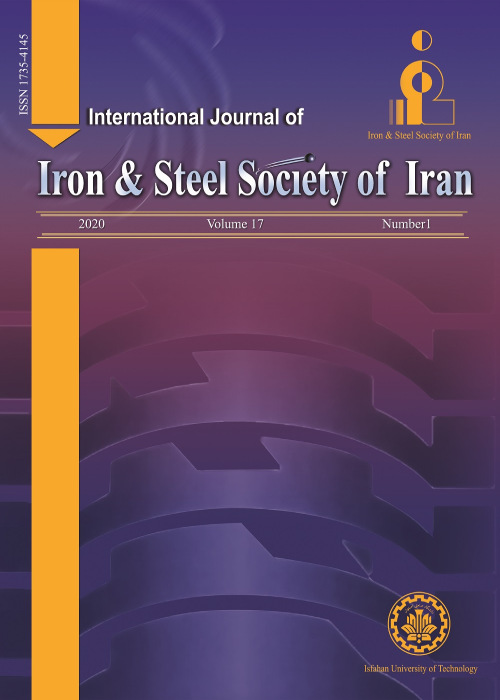فهرست مطالب

International Journal of iron and steel society of Iran
Volume:9 Issue: 1, Summer and Autumn 2012
- تاریخ انتشار: 1392/07/11
- تعداد عناوین: 7
-
-
Pages 1-5In the present study, Ni-P-CNT composite coating was successfully fabricated via electroless plating. Scanning electron microscopy (SEM) was used to characterize the coatings. The effect of CNTs concentration in the bath on its content in the composite coatings was studied. Furthermore, the corrosion behaviour of the coatings with different contents of CNTs was evaluated using Tafel polarization and electrochemical impedance spectroscopy (EIS) methods in 3.5 wt.% NaCl aqueous solution at the room temperature. The results showed that the corrosion resistance of the Ni–P-CNT composite coatings was excellent in comparison with that of the Ni-P coatings and the content of incorporated CNTs played a key role in the passivation and corrosion resistance.Keywords: Carbon nanotubes, Electroless plating, Composite coating, Corrosion resistance
-
The Effect of Niobium on the Formation of Nanostructured Low Carbon Steel Using Martensite TreatmentPages 6-10The formation of nano/ultrafine grained ferrite in low carbon steels containing different amounts of niobium was investigated using thermomechanical treatment which consisted of annealing of 85% cold rolled martensite with different parameters. The specimens were characterized by optical and scanning electron microscopy and Vickers hardness test. A lamellar dislocation cell structure was formed during cold rolling. An increase in hardness was found during annealing with the addition of the Nb element. The mean grain size of the specimens annealed at 550 ºC for 300 s was approximately similar (ranging from 79 to 87 nm) for both chemical compositions. Increasing annealing temperature to 600 ºC or annealing time to 2.7 ks led to a severe grain growth in the steel without Nb, but no considerable changes in Nb containing steel were observed.Keywords: Ultrafine, Nano grained structure, Niobium, Cold rolled martensite, Grain growth
-
Pages 11-14This study was conducted in order to investigate the influence of plastic deformation on the transformation of retained austenite in a TRIP steel with a high content of Al and a low content of Si. To the aim, appropriate treatments were used to produce the starting material (TRIP steel). The microstructure of the obtained steel was composed of bainite and phases including ferrite and retained austenite. Afterwards, 40 % plastic deformation was applied to the starting material using a rolling machine. Microhardness test, microstructural investigations and determination of volume fraction of retained austenite by x-ray diffraction method before and after 40% cold work demonstrated that the volume fraction of retained austenite in the starting material was decreased as the plastic deformation was increased. During the plastic deformation, large grains of retained austenite were transformed to martensite while the small ones tended to be stable.Keywords: TRIP steel, Retained Austenite, Transformation
-
Pages 15-19Advanced high strength steels (AHSS) have recently attracted great attention because of their superior mechanical properties. A modern group of these steels, known as twinning induced plasticity (TWIP) steels, shows a unique combination of strength and ductility even at high rates of strain. In order to examine the functionality of such steels in dynamic loading conditions, their mechanical behavior should be characterized by high strain rate experiments. Regarding the precision of its results and characteristics of the loading pulse, the torsional Kolsky bar experiment has well-known advantages over similar high rate experiments. In this study, a high strain rate torsional testing machine was designed and constructed. By using high strain rate torsional experiments in the range of strain rates from 500 to 1700 /s, mechanical behavior of two high manganese steels with different levels of carbon (0.49 and 0.07 wt%) was surveyed. Through the experiments, it was observed that the phenomenon of adiabatic temperature rise considerably decreased the work hardening rate during the dynamic testing of the high-carbon steel, whereas the low-carbon steel showed a definitely higher hardening rate. The influence of pre-straining on the dynamic mechanical behavior of this low-carbon steel was also studied.Keywords: High strain rate, Torsional test, High manganese steel, pre, strain
-
Pages 20-25In this study, the effects cold rolling and annealing parameters during thermomechanical processing of the AISI 201LN stainless steel were investigated. The cast samples were homogenized, hot-rolled and solution-annealed to acquire a suitable microstructure for the subsequent thermomechanical treatment. Unidirectional and transverse multi-pass cold rolling at 25, 0 and -15 °C was carried out to 90% reduction in thickness, followed by annealing at temperature range of 700–900 °C for different times of 15–1800 s. Microstructures were characterized by optical and scanning electron microscopy, X-ray diffraction and feritscope measurements. Hardness test was also used for evaluating mechanical properties of the specimens. The results showed that the saturation strain of martensite formation during the cold rolling at 25, 0 and -15 °C in 201LN stainless steel was about 0.29, 0.23 And 0.17, respectively. A nano/ultrafine grained structure was formed by annealing the 90% cold rolled specimen at 800 °C for 60 s with a grain size of about 300 nm.Keywords: Martensite thermomechanical processing, 201LN stainless steel, Strain, induced martensite, Nitrogen
-
Pages 26-29Spark plasma sintering (SPS) method, as plasma activated sintering, is a method applicable for rapid sintering of metals and ceramics. Owing to the advantage of rapid heating, the alumina ceramics obtained by SPS have a grain size and density comparable to those of hot pressed ones. The increase of densification rate may be related to some difference in ion transport characteristics. This study describes creep behavior and deformation mechanisms of alumina based materials densified by SPS, and somewhat comparison is made with hot pressing (HP) at high temperature. Pure alumina was densified by SPS at 65 MPa (1200 ºC) and 45 MPa (1400 ºC) by HP. The grain size of the alumina HPed was twice more than the grain size of the sample SPSed. Compressive creep tests in air were performed at different true stresses up to100 MPa and different temperatures (1200 ºC-1400 ºC). The grain growth was found to be more active during creep of SPS alumina than the creep of HP alumina. Generally, the fineness of SPS materials microstructure speeded up all processes related to diffusion. The ratio of dynamic to static grain growth in SPSed samples was twice more than HPed samples during creep test.Keywords: Creep, Alumina ceramics, Sintering, Spark plasma sintering (SPS), Hot pressing (HP)
-
Pages 30-40Quality inspection is an indispensable part of modern industrial manufacturing. Steel as a major industry requires constant surveillance and supervision through its various stages of production. Continuous casting is a critical step in the steel manufacturing process in which molten steel is solidified into a semi-finished product called slab. Once the slab is released from the casting unit, the surface often has longitudinal or transverse cracks. Being exposed to air, the crack surfaces oxidize and do not weld during rolling. The early detection of these defects on the slab saves significant time, effort and production expense, reduces costs, and prevents wasted processing steps and rolling mill faults. Traditionally, the inspection process has been carried out visually through human inspectors. However, human inspection is subjective, error-prone, tedious and time consuming. This paper presents an initial study to validate the feasibility of automated inspection of continuously cast hot slabs using computer vision techniques. An automated inspection system such as the one described in this paper can inspect a slab coming out of a caster while it is still hot. The image processing techniques applied in this work including wavelet transform, morphological operations, edge detection and clustering are time-efficient and simply applicable in industrial applications which demand online computations. The experimental results with 97.0% sensitivity and 96.0% specificity demonstrated that the proposed algorithm was effective and reliable. To the best of our knowledge, this is the first time that such a computerized algorithm has been applied in Iran’s steel industry for quality inspection of continuously cast hot slabs.Keywords: Automatic inspection, Continuously cast slabs, Surface crack, Morphological operations, Edge detection, Color clustering, Neural network


